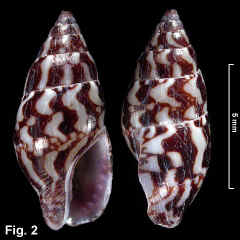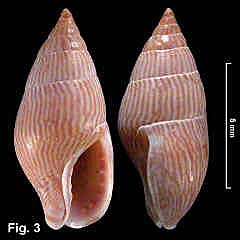|
|
|
|
|
Mitrella bicincta (Gould, 1860) Description: Shell variable in height to width ratio; spire concave for first two whorls, then convex; whorls rounded, aperture more than 1/3 shell length; protoconch 2 ¼ smooth whorls. Spiral sculpture of cords on base and faint microscopic threads over whole surface; axial sculpture entirely absent. Outer lip sinuous in profile, with shallow sinus. Lip thickened externally; slightly thickened internally with 5-8 denticles. Columella callus sharp-edged, axial ridge inside edge bearing small denticles, anterior-most denticle being most prominent. Siphonal canal short. Colour variable, but with four basic patterns: (a) dense network of small white spots, with spiral bands of larger white spots or splashes or axial bands below suture, at midbody and base (Fig.1) (b) axial brown bands on a white background (Fig. 2) (c) dense axial brown lines on a white background (Fig. 3) (d) uniformly fawn or orange-brown. Violet colour within aperture or around outer lip denticles in fresh specimens, rapidly fading to lilac then creamish-brown. Periostracum smooth. Size: Up to 12 mm in length. Distribution: Endemic to Japan, southern Korea and Hong Kong; introduced to Australia. In Australia, Woody Head, Iluka, NSW, southwards to Gabo Is., Victoria. Habitat: On algae and under stones intertidally and in the shallow subtidal, on exposed and semi-sheltered rocky shores. Synonymy: This is not Columbella bicincta Angas, 1871. That name was introduced by Angas for the shell now known as Mitrella peroniana (Hedley, 1913), but was preoccupied. Remarks: This species was introduced to Australia from east Asia in the early 1960s and is now naturalised here (Beechey & Willan, 2007). It is common to abundant around Sydney. The earliest specimens were collected in 1964. Some Australian literature has figured this species without recognising it as introduced; Robinson & Gibbs (1982, p. 48) figured it as a representative of the Columbellidae in NSW estuaries! Jansen (1995, p. 249) and Jansen (2000, p. 52) figured it as Metanachis sp. The live animal and shells from Japan are figured by Okutani (2000); the colour patterns shown there are the same as those seen in NSW specimens. Fig. 1: Shark Island, Sydney Harbour (C.456760) Fig. 2: Shark Island, Sydney Harbour. Protoconch missing and lip broken. (C.456760) Fig. 3: Long Reef, Collaroy, NSW (C.204561) |


